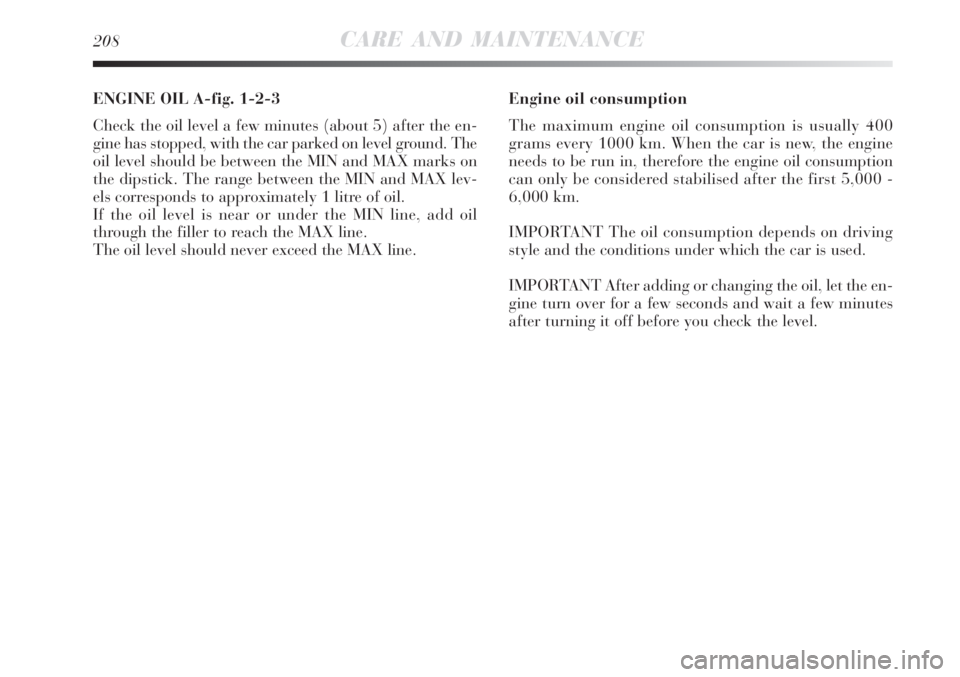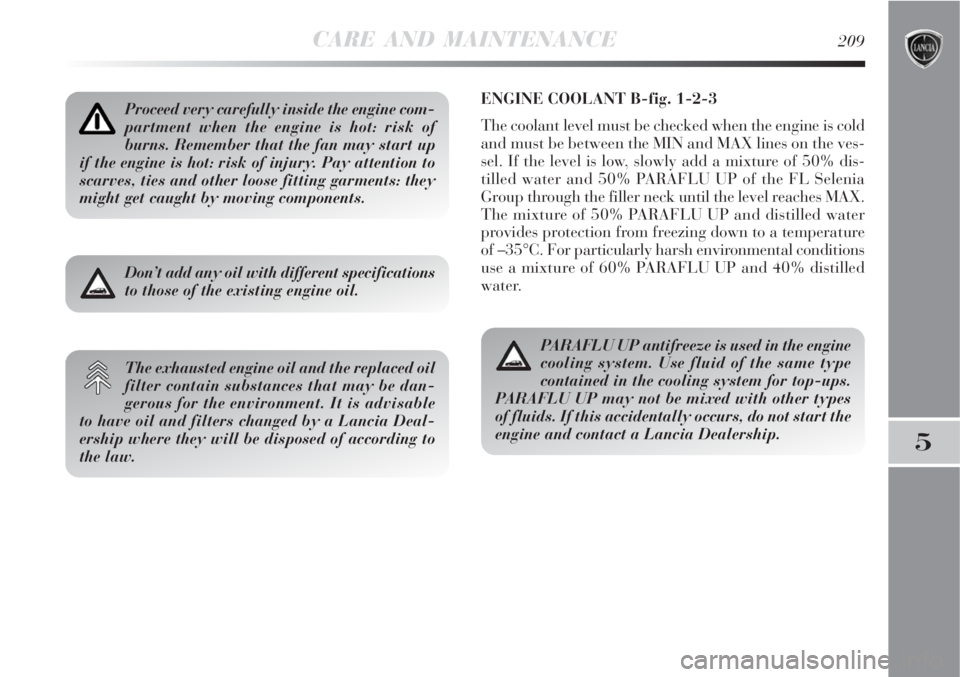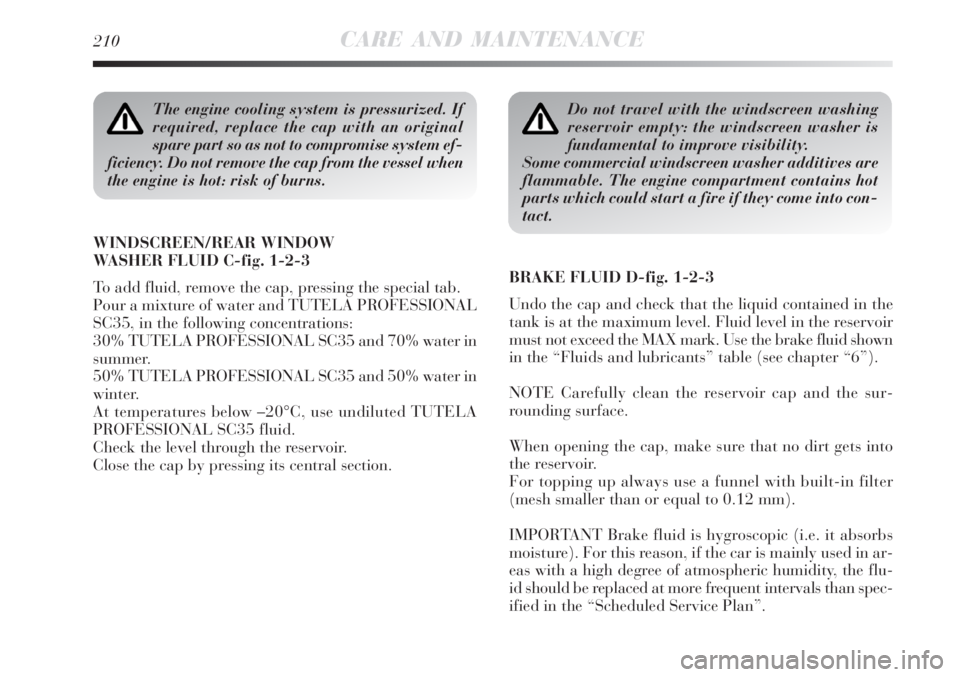check engine Lancia Delta 2009 Owner handbook (in English)
[x] Cancel search | Manufacturer: LANCIA, Model Year: 2009, Model line: Delta, Model: Lancia Delta 2009Pages: 258, PDF Size: 4.93 MB
Page 209 of 258

208CARE AND MAINTENANCE
ENGINE OIL A-fig. 1-2-3
Check the oil level a few minutes (about 5) after the en-
gine has stopped, with the car parked on level ground. The
oil level should be between the MIN and MAX marks on
the dipstick. The range between the MIN and MAX lev-
els corresponds to approximately 1 litre of oil.
If the oil level is near or under the MIN line, add oil
through the filler to reach the MAX line.
The oil level should never exceed the MAX line.Engine oil consumption
The maximum engine oil consumption is usually 400
grams every 1000 km. When the car is new, the engine
needs to be run in, therefore the engine oil consumption
can only be considered stabilised after the first 5,000 -
6,000 km.
IMPORTANT The oil consumption depends on driving
style and the conditions under which the car is used.
IMPORTANT After adding or changing the oil, let the en-
gine turn over for a few seconds and wait a few minutes
after turning it off before you check the level.
Page 210 of 258

CARE AND MAINTENANCE209
5
ENGINE COOLANT B-fig. 1-2-3
The coolant level must be checked when the engine is cold
and must be between the MIN and MAX lines on the ves-
sel. If the level is low, slowly add a mixture of 50% dis-
tilled water and 50% PARAFLU UP of the FL Selenia
Group through the filler neck until the level reaches MAX.
The mixture of 50% PARAFLU UP and distilled water
provides protection from freezing down to a temperature
of –35°C. For particularly harsh environmental conditions
use a mixture of 60% PARAFLU UP and 40% distilled
water.Proceed very carefully inside the engine com-
partment when the engine is hot: risk of
burns. Remember that the fan may start up
if the engine is hot: risk of injury. Pay attention to
scarves, ties and other loose fitting garments: they
might get caught by moving components.
Don’t add any oil with different specifications
to those of the existing engine oil.
The exhausted engine oil and the replaced oil
filter contain substances that may be dan-
gerous for the environment. It is advisable
to have oil and filters changed by a Lancia Deal-
ership where they will be disposed of according to
the law.
PARAFLU UP antifreeze is used in the engine
cooling system. Use fluid of the same type
contained in the cooling system for top-ups.
PARAFLU UP may not be mixed with other types
of fluids. If this accidentally occurs, do not start the
engine and contact a Lancia Dealership.
Page 211 of 258

210CARE AND MAINTENANCE
The engine cooling system is pressurized. If
required, replace the cap with an original
spare part so as not to compromise system ef-
ficiency. Do not remove the cap from the vessel when
the engine is hot: risk of burns.
WINDSCREEN/REAR WINDOW
WASHER FLUID C-fig. 1-2-3
To add fluid, remove the cap, pressing the special tab.
Pour a mixture of water and TUTELA PROFESSIONAL
SC35, in the following concentrations:
30% TUTELA PROFESSIONAL SC35 and 70% water in
summer.
50% TUTELA PROFESSIONAL SC35 and 50% water in
winter.
At temperatures below –20°C, use undiluted TUTELA
PROFESSIONAL SC35 fluid.
Check the level through the reservoir.
Close the cap by pressing its central section.
Do not travel with the windscreen washing
reservoir empty: the windscreen washer is
fundamental to improve visibility.
Some commercial windscreen washer additives are
flammable. The engine compartment contains hot
parts which could start a fire if they come into con-
tact.
BRAKE FLUID D-fig. 1-2-3
Undo the cap and check that the liquid contained in the
tank is at the maximum level. Fluid level in the reservoir
must not exceed the MAX mark. Use the brake fluid shown
in the “Fluids and lubricants” table (see chapter “6”).
NOTE Carefully clean the reservoir cap and the sur-
rounding surface.
When opening the cap, make sure that no dirt gets into
the reservoir.
For topping up always use a funnel with built-in filter
(mesh smaller than or equal to 0.12 mm).
IMPORTANT Brake fluid is hygroscopic (i.e. it absorbs
moisture). For this reason, if the car is mainly used in ar-
eas with a high degree of atmospheric humidity, the flu-
id should be replaced at more frequent intervals than spec-
ified in the “Scheduled Service Plan”.